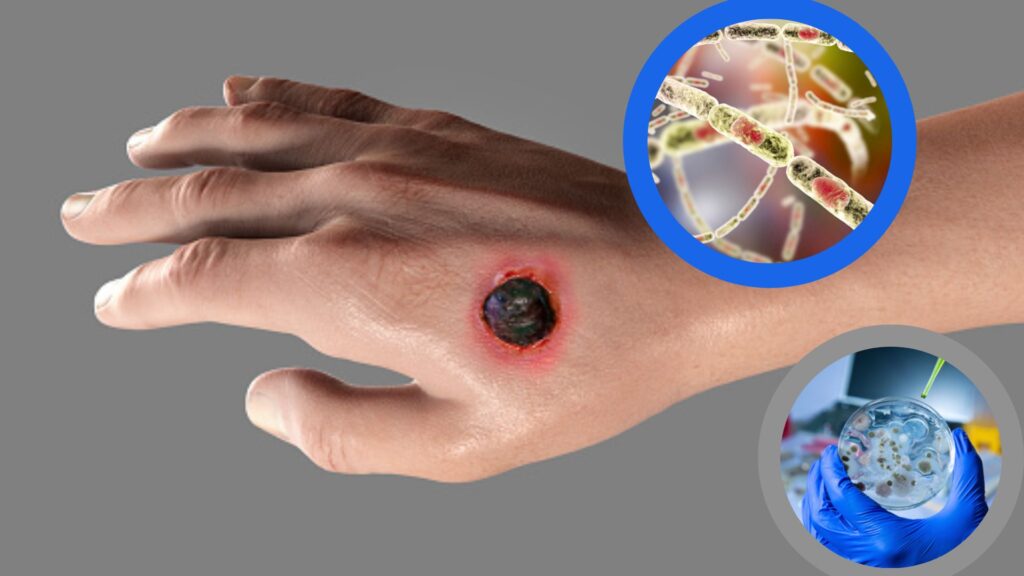Anthrax : Definition, symptoms & treatment
Anthrax
We have described in article :
Definition of anthrax
Symptoms of anthrax
Investigations of anthrax
Treatment of anthrax
Control measures of anthrax
Epidemiology of anthrax

Definition of anthrax :
Anthrax : Anthrax is a disease of wild or domestic animals caused by the bacteria Bacillus anthracis that is transmitted to man. The characteristic lesion of human anthrax is a necrotic cutaneous ulcer (malignant pustule).
Occurrence : Distribution is world-wide. It is particularly seen amongst workers handling contaminated skin, hides, wool, hair, bone & bone products, veterinarians and agricultural workers who handle infected animal.
Clinical features /symptoms of anthrax :
1) Cutaneous anthrax :
- A single lesion develops as an irritable papule on an oedematous haemorrhagic base.
- This progresses to a depressed black eschar.
- Despite extensive oedema, pain is infrequent.
2) Gastrointestinal anthrax :
- Nausea, vomiting, anorexia.
- Fever.
- Severe abdominal pain
- Bloody diarrhoea.
- Toxaemia and death can develop rapidly thereafter.
3) Inhalational/pulmonary anthrax :
- Fever
- Dyspnoea
- Cough
- Headache Symptoms of septicaemia.
- Pleural effusion
- Meningitis may occur.
Investigations for antharx :
- Demonstrating the organism in smears from cutaneous lesions or by culture of blood and other body fluids.
- Serological confirmation by ELISA detecting antibodies to both the organism and a toxin.
Treatment of anthrax :
- Inj. Benzyl-penicillin with dose up to 24 gm iv. 4-hourly for 10 days
- Or
- Tab Phenoxymethyl-penicillin 500 1000 mg 6-hourly for 10 days.
- The addition of an aminoglycoside may improve the outlook in severe disease.
- Tab. Ciprofloxacin 500 mg 12 hourly until penicillin susceptibility is confirmed
- In view of concerns about concomitant inhalational exposure, particularly in the era of bioterrorism, a further 2-month course of ciprofloxacin 500 mg 12-hourly or doxycycline 100 mg 12-hourly orally is added.
Control measures of anthrax :
- Enforcement of health measures in the industries dealing with skin and hides, wool and hairs, bone and bone products, etc.
- Vaccination of animals at risk.
- Education of people about the mode of transmission of the disease.
- Vaccination of high-risk groups, such as veterinarians and those handling potentially contaminated industrial raw materials.
- Notification to local health authority.
- Disinfection of soiled articles.
- Specific treatment : Penicillin is the drug of choice Ciprofloxacin. Sulphonamides chloramphenicol and tetracycline have also been used successfully.
Epidemiology of anthrax :
Occurrence : Distribution is world-wide. It is particularly seen amongst workers handling contaminated skin, hides, wool, hair, bone & bone products, veterinarians and agricultural workers who handle infected animals.
Epidemiological determinants : 1) Agent : Bacillus anthracis.
2) Reservoir : Spores of Bacillus anthracis may remain viable for years in contaminated soil and processed skins and hides.
3) Modes of transmission :
- Infection of skin is by contact with tissues of animals (cattle, sheep, goats, horses, pigs and others) dying of the disease and possibly by biting flies which had partially fed on such animals, or contaminated hair, wool, hides, or products made from them, such as drums, brushes etc. and soil associated with infected animals.
- Pulmonary anthrax results from inhalation of spores of the bacillus.
- Intestinal anthrax arises from ingestion of contaminated undercooked meat.
- Accidental infections may occur among laboratory workers.
4) Incubation period : Within 7 days, usually 2 to 5 days.
5) Period of communicability : Articles and soil contaminated with spores may remain infective for years.
